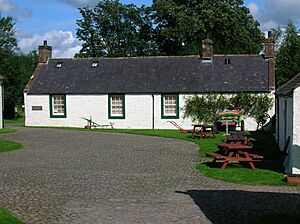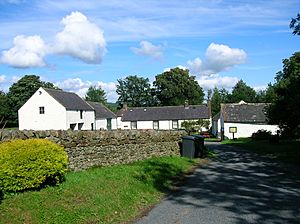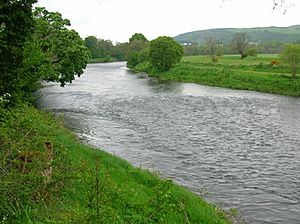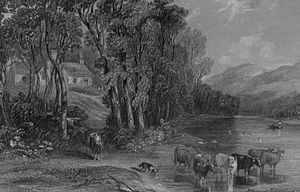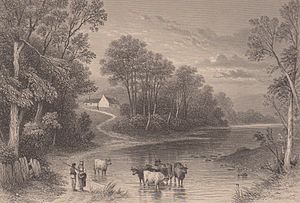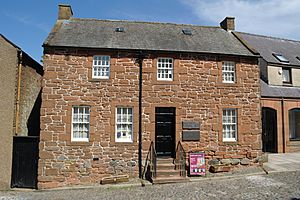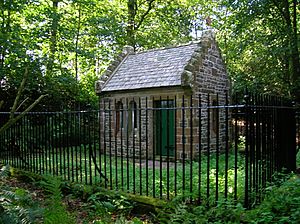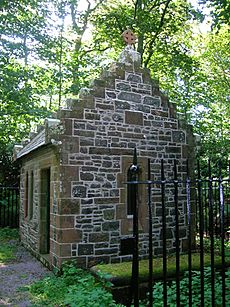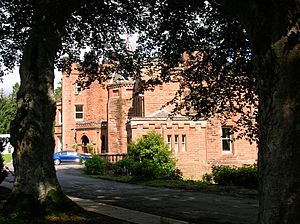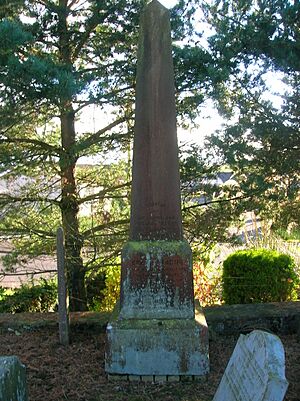Ellisland Farm facts for kids
Ellisland Farm is a special place located about 10.4 kilometers (6.5 miles) northwest of Dumfries, near the village of Auldgirth in Scotland. It's a museum because the famous Scottish poet, Robert Burns, built, lived, and farmed here from 1788 to 1791. It's a chance to step back in time and see where one of Scotland's greatest writers found inspiration!
Contents
Ellisland Farm: A Poet's Home
Ellisland Farm is a historic site where Robert Burns, Scotland's national poet, lived and worked. The farm is located by the beautiful River Nith. Before Burns moved here, the land was quite wild and not very fertile.
Choosing Ellisland: Robert Burns's Decision
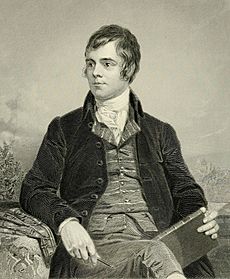
Patrick Miller of Dalswinton, a friend of Robert Burns, offered him a choice of three farms. Burns chose Ellisland, even though some parts of it were stony. He visited the farm on February 27, 1788, and decided it was the right place for him. He signed a long lease for the farm, agreeing to pay rent each year.
Burns wrote to his friend Patrick Miller in 1787, saying he wanted to be a farmer on a small farm in a pleasant country. He wanted to live simply and work hard. He also mentioned how beautiful the banks of the River Nith were, calling them "sweet poetic ground."
Life at Ellisland: The Burns Family Home
Robert Burns started farming at Ellisland on June 11, 1788. At first, there was no farmhouse or farm buildings. Patrick Miller gave Burns money to build a house, a barn, and other farm structures.
Robert had married Jean Armour on March 20, 1788. They moved into Ellisland Farm in June 1789 with their young son, Robert. To bring good luck, they entered their new home in their best clothes. A servant carried the family bible, and an oat-cake was broken over Jean's head. They celebrated with friends and neighbors.
Jean Armour was known as a good and careful housewife. She kept the house neat and tidy and made sure everyone had plenty of food. Two of Burns's sons, Francis Wallace and William Nicol, were born at Ellisland. His half-sister, Betty, also spent her first months here.
The Farm and Its Land
The house Robert Burns built was a one-story building with rooms for servants upstairs. It had a living room and a sitting room, with a window that offered great views. The kitchen and a bedroom were in the middle. The main walls of the house today are likely the same ones from 1788.
The land at Ellisland was about 69 hectares (170 acres). It was quite challenging to farm because it was stony and not very fertile. Burns had cows, horses, and some pet sheep. He introduced a new way of farming called the Ayrshire dairying system, which helped produce more milk. He also grew crops like oats.
Burns was one of the first farmers in the area to bring in Ayrshire cattle. Other farmers soon followed his example when they saw how much more milk these cows produced.
Leaving Ellisland: A New Chapter
Robert Burns eventually decided to leave farming. He also worked as an exciseman, collecting taxes on goods. This job required him to travel long distances each week. By 1790, the farm rent increased, and Burns felt that farming was not working out well for him.
On November 11, 1791, the Burns family left Ellisland Farm. They moved to the town of Dumfries, about 10 kilometers (6 miles) away.
Ellisland After Burns: A Farm's Journey
After Robert Burns left, Patrick Miller sold Ellisland Farm. The farm continued to be worked until 1921. Over the years, some changes were made to the farm buildings, but the farmhouse itself largely remained as it was when Burns lived there.
Poems and Songs from Ellisland
During his time at Ellisland, Robert Burns was incredibly creative. He wrote many famous poems and songs here.
Masterpieces and Melodies
One of his most famous poems, Tam o'Shanter, was written at Ellisland. He sent it to his friend Francis Grose in December 1790.
Burns also wrote Auld Lang Syne at Ellisland. This song is now sung all over the world, especially on New Year's Eve. He sent the first version to his friend Mrs. Dunlop in December 1788. He loved old Scottish songs and felt that Auld Lang Syne was very special.
While living at Ellisland, Burns wrote over 130 songs and poems. This is about a quarter of all the works he ever created! Even though he was busy farming and working as an exciseman, he also wrote around 230 letters. He wrote the drinking song Willie Brew'd a Peck o'Maut during this time.
Burns wrote many songs for a young woman named Jean Lorimer, who often visited Ellisland. He called her "Chloris" in his poems. He also composed Mary in Heaven in the farm's yard.
Burns wrote many letters to Mrs. Agnes Craig McLehose, a friend he called 'Clarinda'. Their letters inspired one of his most famous love songs, 'Ae Fond Kiss'.
He also wrote On seeing a Wounded Hare limp by me, which a Fellow had just shot. This poem was inspired by an event where a local farmer's son shot a hare out of hunting season, which made Burns very upset.
The Hermitage: A Quiet Writing Spot
Robert Burns's neighbor, Captain Robert Riddell of Glenriddel, had a small summer house called the 'Hermitage' on his estate, not far from Ellisland. Burns often used this peaceful spot for writing poetry. He even had a key to the building.
The original Hermitage building is no longer there, but a new one was built in the 19th century on the same spot. It was restored in 2009 and now has information boards about its history.
Burns wrote some lines on the window of the original Hermitage:
|
"Thou whom chance may hither lead, Life is but a day at most, |
The original window with these lines is now kept at the Ellisland Farm museum.
Interesting Facts About Ellisland
The land where Ellisland Farm stands once belonged to important historical figures like the Red Comyn and Robert the Bruce.
In 1789, Robert Burns witnessed a famous contest at Friar's Carse. The challenge was to see who could be the last person able to blow a whistle. This event was later written about in his poem The Whistle.
On October 14, 1788, Robert Burns saw Patrick Miller's steamboat being tested on Dalswinton Loch. This was a very important moment because it was one of the first times an engine was used for human transportation anywhere in the world.
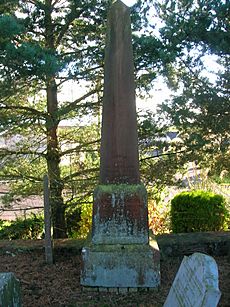
Robert Burns and Robert Riddell also helped set up the Monkland Friendly Society in Dunscore. They organized a library of 150 books for the society. Burns was the secretary of this group.
Patrick Miller was also known for bringing new farming ideas to Scotland, like introducing turnips from Sweden and new types of farm machinery.
Burns's uncle, Robert Burness, lived at Ellisland for a time and passed away there in January 1789.
Ellisland Farm Museum: Visit and Explore
Ellisland Farm was a working farm until 1921. Then, John Wilson, a former president of the Edinburgh Burns Club, bought it and gave it to the nation. Since 2020, The Robert Burns Ellisland Trust has been taking care of Ellisland.
Today, visitors can explore the 18th-century farmstead. Inside, you can see items that belonged to Robert Burns and his family, like his manuscripts and his wife Jean's milking stool. The kitchen still has part of the original cooking range.
The old Granary and other farm buildings were opened as a museum in 1979. Here, you can learn about farming life from the past. There's also an audio-visual show in the Granary. You can enjoy walks along the riverside, which are the same paths that inspired Burns during his most creative years. The museum also has a collection of old farm tools and equipment from all over Scotland.
Views of Ellisland Farm Today
Interesting Facts About Ellisland
The land where Ellisland Farm stands once belonged to important historical figures like the Red Comyn and later Robert the Bruce. North of the farm, there was a place believed to be a camp built by the Roman general Agricola. Burns even used "Agricola" as a secret pen name for some of his writings.
In 1789, Burns witnessed a famous contest at Friar's Carse. People competed to see who could blow a whistle the longest. The winner received an old ebony whistle as a prize. Burns wrote a poem about this event called The Whistle.
In 1788, Robert Burns is said to have watched trials of Patrick Miller's paddle-driven steamboat on a nearby loch. This was a very important moment because it was one of the first times an engine was used to power human transportation anywhere in the world!
Robert Burns and Robert Riddell also started the Monkland Friendly Society in Dunscore. They organized a library of 150 books for the society. Riddell was the president, and Burns was the secretary.
Patrick Miller was also known for bringing new things to Scotland. He introduced "Swedes" (a type of turnip) from Sweden, as well as the threshing mill and the drill plough.
Burns's uncle, Robert Burness, died at Ellisland in 1789. Burns took care of his daughter, Fanny Burness.
Burns apparently left his favorite "putting stone" at Ellisland. If he saw anyone using it, he would join in and always show that he was the strongest.
See also


